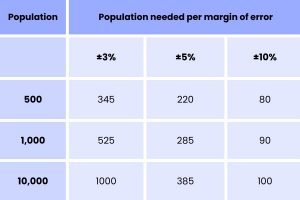Business-to-business (B2B) market research is the practice of gathering data from B2B buyers in a specific industry to inform business strategies. Conducting market research helps businesses that create products or services for other companies understand the needs, pain points, and motivations of their audience.
Surveys are arguably the most common B2B research method. However, one of the biggest challenges in conducting this type of project is finding relevant survey respondents. The cost could be astronomical, especially if you’re looking for people in senior roles or those in a specific B2B niche.
Recruiting the right people is essential for effective survey research. Using the proper tactics and tools, you can quickly find qualified respondents to provide meaningful data. In this blog, we’ll explore the best strategies to find and engage your ideal B2B survey respondents.
A. Identifying Your Target Audience
The first step to recruiting participants is to define your target sample. Identifying a B2B respondent base for your survey criteria is complicated because different roles can be involved.
Take some time to identify the organizations and individuals you would like to join in the study. Having a mix of people from different departments and segment sizes ensures that your sample is representative of the target population.
Ideally, you would want to recruit decision-makers or “top dogs” within the organization. These key influencers usually have the final say in buying the product or service covered by your survey.
Sample Criteria
Age: 40 to 50 years old
Location: US-based
Job Role: C-Level Executives
Company Size: Small and Mid-Size Enterprises (SME)
Industry: Food and Beverage
Department: Marketing, Operations, Product Development
Key Takeaway
B. Selecting A Sample Size
Each survey has its own unique research objectives, budget, timeline, criteria, and other KPIs. Hence, there is no “one size fits all” approach to how large your sample size should be for a statistically reliable B2B survey.
Consider these tips when selecting a sample size for B2B recruiting:
1. Aim for a number of responses on a ±3% to ±5% margin of error. As the margin of error increases, your results become less reliable. Keeping within this range creates a balance between high-quality responses and low recruitment costs.
This table shows the number of respondents you would need for a ±3%, ±5%, and ±10% margin of error.

2. Consider how much each survey response would cost. Because B2B respondents are harder to reach and engage compared to B2C, expect to pay an average of $20 to $150 per complete.
3. Recruit a larger sample if you plan to segment your results. Have about 50-100 in each segment to collect meaningful insights.
4. Prioritize seniority over large sample numbers. Even though recruiting senior-level executives can be costly, their responses carry a lot of weight.
Key Takeaway
Selecting the right sample size is crucial for obtaining statistically reliable results. Businesses should balance the need for a smaller margin of error with the costs associated with recruiting senior-level B2B respondents, who often provide more valuable insights despite being more challenging to recruit.
C. Recruiting B2B Respondents
B2B respondent recruitment is often more difficult than B2C due to smaller populations, harder-to-reach people (e.g., busier, less willing to participate, lots of gatekeepers), and more specific qualifications. For these reasons, finding a sufficient number of individuals to participate in your surveys may be challenging.
Luckily, there are several strategies you can use to gather a suitable respondent pool for your B2B surveys.
1. Use CRM Software
Leveraging customer relationship management (CRM) software for research recruitment is a cost-effective way to gather respondents that have already shown an interest in the business. This database contains a list of leads and customers you can segment, target, and reach out to for a better chance of getting high response rates.
When using this tactic, ensure your CRM data is up-to-date and diverse enough for your project. If you reach out to the wrong people using outdated information or if your sample is too biased, this can lead to poor data quality.
TIP: Target lost leads if your questions focus on new products or improvements. This lets you gather valuable feedback that could attract new leads or win back customers.
2. Set Up Intercepts on Your Site
This recruitment strategy is useful if your website or app generates traffic. You can use intercepts such as pop-ups or static widgets at the corner of your site to entice website or app users into completing your survey.
Website intercepts are also ideal for conducting B2B user experience (UX) testing. Studies show that people only take a mere 0.05 seconds to form a first impression on your site. Using this strategy allows you to get in-the-moment feedback from your visitors.
TIP: In the intercept, you should include the survey topic, the completion time, and the survey link. This improves your chances of getting responses from qualified people.
3. Network on Social Media (LinkedIn)
Social media, specifically LinkedIn, gives you access to a wide variety of B2B professionals for your survey. As a dedicated platform for professionals, LinkedIn has various built-in features you can use to your advantage when searching for B2B participants.
LinkedIn’s search functionality allows you to target specific industries, demographics, and geographies – helping you narrow down your search to the most qualified respondents. Furthermore, you can also direct message potential respondents and share survey links.
TIP: If you want to spread the word about your project, you can use sponsored ads to have your survey show up on the feeds of your potential respondents.
4. Source from Online Panels
Getting your survey sample from an online panel is a good option for broader B2B populations. These panels consist of pre-screened panelists that you can invite for B2B market research.
When using an online panel, you’ll typically pay a cost-per-complete (CPC) based on the incidence rate of your sample pool. For example, if only 5 out of 100 people qualify and complete your survey, you’ll only incentivize those five people.
TIP: Avoid drawing your respondents from online panels if you're looking to target a niche profession (<1% of the population) or geography (e.g., counties, zip codes, designated market area). Online panelswill likely not have enough people to fill your quota.
5. Hire A Recruitment Firm
Hiring a recruitment firm is the best option if you’re strapped for time or don’t want to source your respondents manually. These solutions access large pools of B2B respondents from various broad and niche sectors to quickly source qualified respondents for your B2B surveys.
Recruitment firms are experienced in ethical respondent recruitment and working with tight deadlines. This ensures that your survey responses are valid, reliable, and completed on time. Additionally, this approach also gives you the option to recontact the same respondents for future research.
TIP: For a seamless research experience, look for a recruitment solution that provides services such as screener writing and review, respondent authentication, incentive processing, and real-time updates.
Key Takeaway
Depending on different factors, there are multiple channels wherein you can successfully recruit B2B respondents. This includes leveraging CRM software, setting up website intercepts, networking on LinkedIn, sourcing from online panels, and hiring a recruitment firm. Each method offers distinct advantages based on your research goals, timeline, and budget.
Solve Your Respondent Recruitment Challenges Through CiviSelect™ Recruiting
CiviSelect has the resources to provide the most suitable respondents for your research study. Let us help you find the participants that will lead your project to success. Contact us and learn more about our respondent recruitment services to take the load off of your B2B project.



